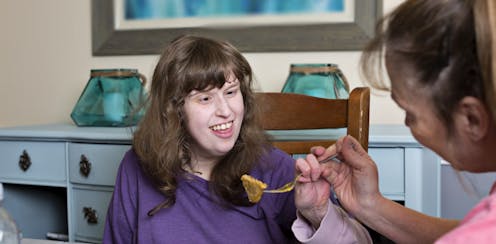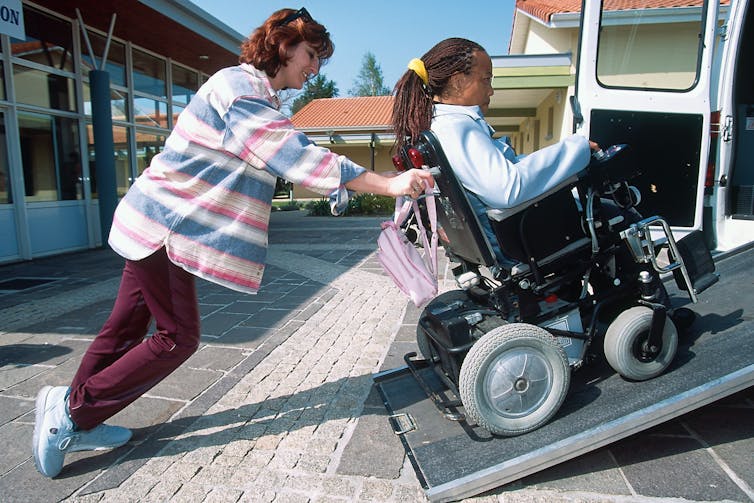Paying caregivers more could boost Nebraska’s economy − new research
Paying the caregivers of people with disabilities more would improve care while increasing economic growth, a research team found.

Paid caregivers foster independence and improve quality of life for people with all kinds of disabilities, many of whom need help getting dressed, preparing meals, showering and dealing with other activities of daily living.
There are over 10,000 paid caregivers of people with disabilities and adults over 65 in Nebraska, where we work and often conduct research. Across the country, there are 3.7 million paid caregivers, and the federal government expects their ranks to grow by 22% over the next decade.
Compensation for these workers, however, is extremely low.
The median hourly wage for Nebraska’s paid caregivers in 2023 was US$13.55 per hour. Although the typical caregiver logs significant amounts of overtime beyond a 40-hour week due to the chronic labor shortage, they still take home just $32,960 per year. And that’s far below the $49,009 annual income, according to one estimate, that single adults needed to make ends meet in Nebraska.
While paid caregiving is among the country’s fastest-growing occupations, the job’s low pay and meager benefits contribute to high turnover. A shortage of these workers is compromising the quality of care and creating long waitlists for people who need it.
About 30% of paid caregivers across the nation work part time for a variety of personal and economic reasons. Some are students. Others are already caring for their children, parents or other relatives. In many cases, their employers don’t pay for employment benefits such as health insurance, retirement plans or paid time off.
Lacking decent benefits can take a toll on job satisfaction and productivity – and cause burnout.
High turnover
The share of paid caregivers who quit within a year varies widely, ranging from 28.5% in the District of Columbia to 59% in Wyoming. About half of Nebraska’s paid caregivers leave their jobs every year.
The National Alliance for Direct Support Professionals, an association that represents caregivers and their employers, estimates that hiring new caregivers costs anywhere from $2,413 to $5,200. Conducting fewer background checks and training new hires less frequently saves the state and federal governments money, given that the employers foot that bill through contracting with state governments.
Unlike in other industries, the employers of caregivers for people with disabilities can’t just pay workers more to make these jobs more alluring. That’s because their wages are set or heavily influenced by state and federal funding levels.
For the most part, caregiver pay is set by Medicaid, the government’s health insurance program for low-income Americans, and Medicare, which provides Americans over 65 and younger people who receive disability benefits with health insurance. States administer Medicaid and share its costs with the federal government.
People with disabilities who frequently get new paid caregivers go to the emergency room more frequently, have more instances of abuse and neglect and get injured more often.
Reducing caregiver turnover not only improves quality of life for people receiving services, it saves tax dollars spent on costly hospital stays covered by Medicaid and Medicare, as well as through lower numbers of abuse investigations and other expenditures that arise when people with disabilities don’t get the care they require.

Caregivers who make more spend more
We teamed up with Ashley Robinson, a social work graduate student at the University of Nebraska at Omaha, to estimate the economic boost Nebraska would get if it compensated caregivers better.
We also worked on this project with Nebraska Association of Service Providers, a nonprofit association that represents the state’s intellectual and developmental service provider organizations.
By analyzing data for similar professions, we determined that paid caregivers are compensated less than their closest counterparts, including child care workers. We estimated that closing the wage gap between paid caregivers and child care workers would require a 5.9% higher starting wage and a 3% increase in the median wage.
Using the IMPLAN multiplier system, which breaks down how changes to an industry can relate to the overall economy, we also calculated that boosting wages by that amount would lead to a rate of return of $1.40 for every $1.00 in additional tax dollars spent on raising pay for caregivers.
We identified three main drivers of this economic boost. First, paid caregiver turnover would decline. Second, many unpaid family caregivers would be able to go back to work – earning a living and paying taxes. Third, state and local tax revenue would rise once caregiver positions were filled.
These factors would amount to an estimated $401.3 million stimulus for Nebraska’s economy.
We believe that our findings illustrate how low pay doesn’t just harm caregivers and their employers. It’s also costly for state governments.
Susan Rebecca Reay was paid by Goss and Associates (co-author) to write a technical report associated with this article. The technical report was funded by the Nebraska Association of Service Providers (NASP), a nonprofit organization supporting people with disabilities and the organizations that support them.
Ernie Goss received funding to write a technical report to support people with disabilities and organizations that support them.
Read These Next
2 superpowers, 1 playbook: Why Chinese and US bureaucrats think and act alike
The men and women tasked with implementing policy are governed by the same incentives and constraints…
My prescription costs what?! Pharmacists offer tips that could reduce your out-of-pocket drug costs
High prescription drug costs are leaving many patients frustrated and unable to afford their medications.
Chile elects most right-wing leader since Pinochet – in line with regional drift, domestic tendency
José Antonio Kast, who has run for the presidency several times, successfully seized on widespread…






